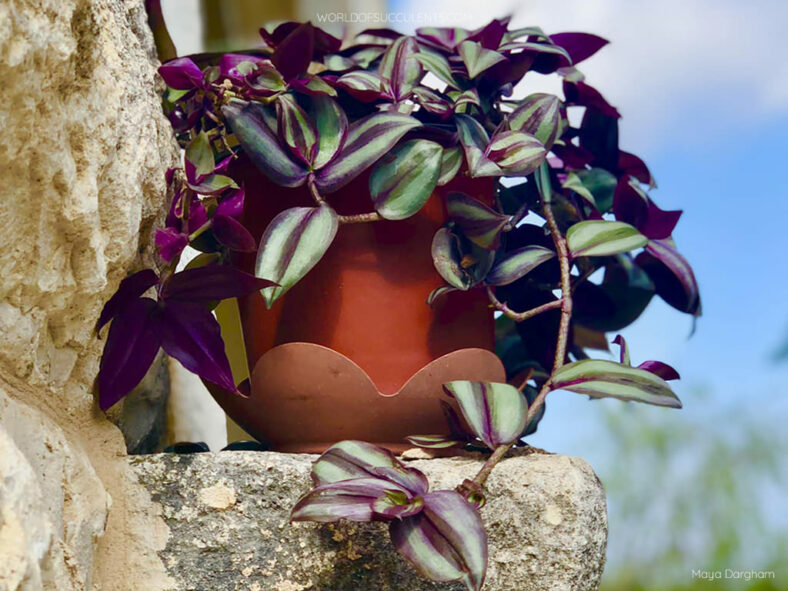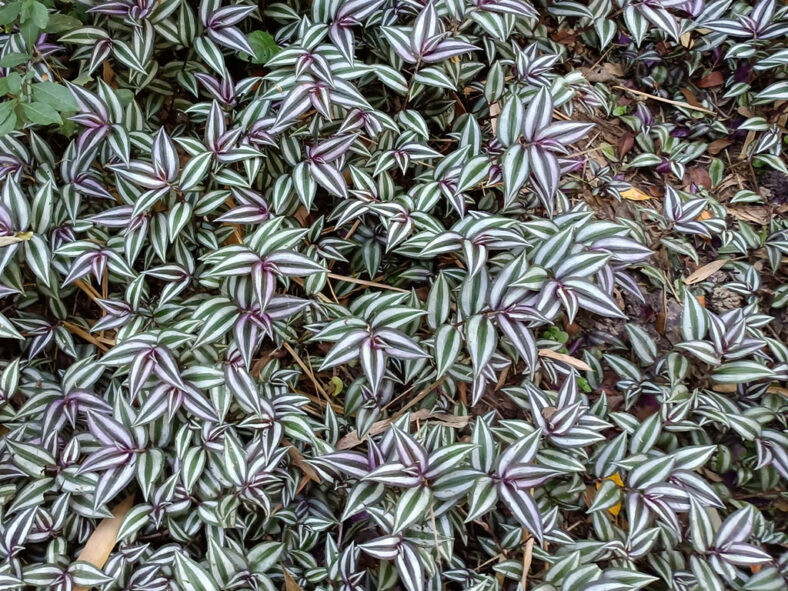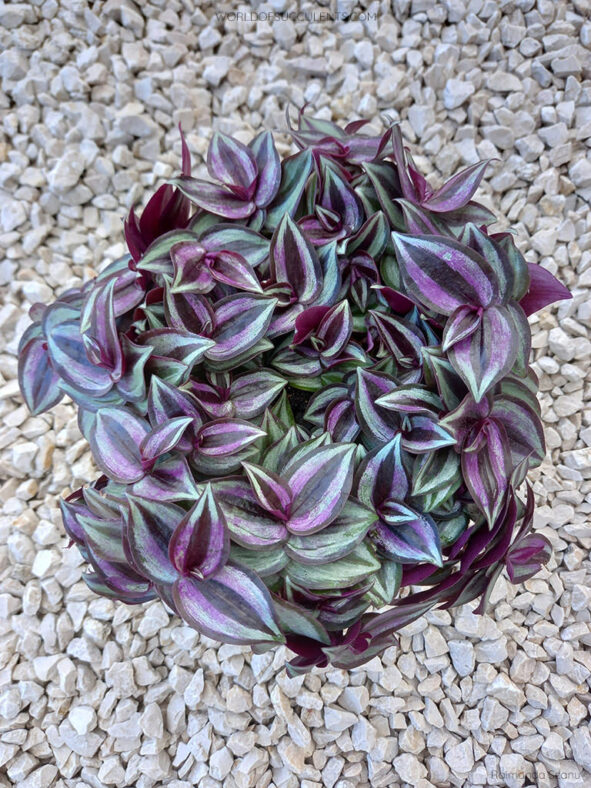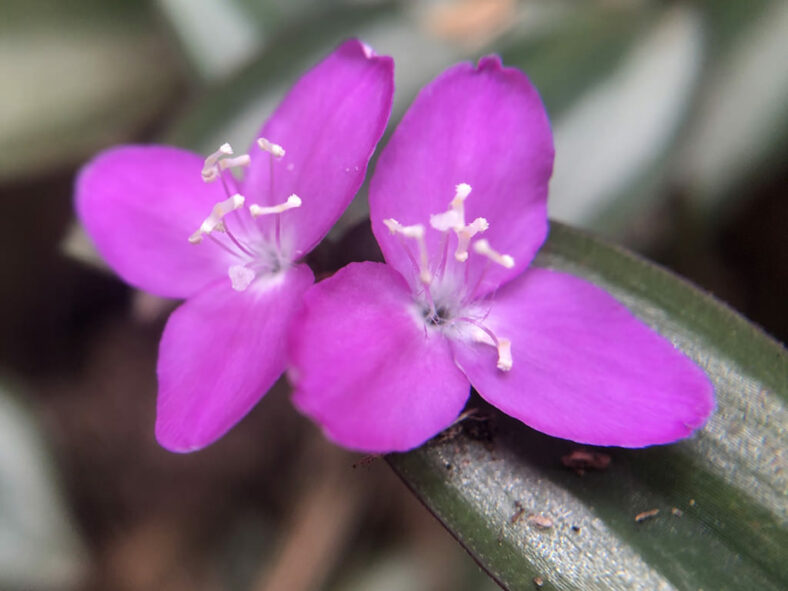Tradescantia zebrina is a highly popular plant due to its fast growth and attractive foliage. It is commonly used as a trailing plant in seasonal containers or as an underplanting with larger houseplants. The species and its cultivars Tradescantia zebrina 'Purpusii' and Tradescantia zebrina 'Quadricolor' have received the prestigious Award of Garden Merit of the UK's Royal Horticultural Society.
Scientific Name
Tradescantia zebrina Bosse
Common Name(s)
Inch Plant, Silver Inch Plant, Wandering Jew (this name is controversial, and some people now prefer to use the alternative Wandering Dude)
Synonym(s)
Commelina zebrina, Cyanotis zebrina, Tradescantia zebrina var. zebrina
Scientific Classification
Family: Commelinaceae
Subfamily: Commelinoideae
Tribe: Tradescantieae
Subtribe: Tradescantiinae
Genus: Tradescantia
Etymology
The specific epithet "zebrina (zeb-REE-nuh)" means "with stripes like a zebra" and refers to the stripes on the upper surface of the leaves.
Origin
Tradescantia zebrina is native to Mexico, Central America, the Caribbean islands, and Colombia. It typically grows in thickets in wetlands and rainforests, often on stones in shady and open areas and river banks. This species has also been introduced and naturalized in some parts of South America, Africa, Asia, Australia, and various oceanic islands.
Description
Tradescantia zebrina is a beautiful trailing plant with slender stems that bear variegated, slightly fleshy leaves. It can grow up to 6 inches (15 cm) tall but can spread to 2 feet (60 cm) or more, often forming a dense mat. The stems are smooth or hairy, densely branched, and root at the nodes as they grow. The leaves are green to purple with two broad, silvery, longitudinal stripes on the upper surface and reddish-purple on the lower surface. They are stem-clasping, mostly ovate with a rounded base and a pointed tip, and can measure up to 4 inches (10 cm) long and 1.3 inches (3.2 cm) wide. The leaves are smooth or sparsely hairy on both surfaces.
The small flowers have three rose-pink to lavender petals and prominent white anthers. Although rarely appear on indoor plants, Tradescantia zebrina can produce flowers sporadically throughout the year. The flowers appear in pairs subtended by two large, leaflike bracts. The fruits are three-locular capsules that contain gray-brown seeds, one or two per locule.

How to Grow and Care for Tradescantia zebrina
Light: Tradescantia zebrina thrives in partial shade, but it can also grow well in sunny areas as long as the soil is kept moist. If the conditions are suitable, this plant can also be grown indoors. Let it spend some time outdoors during the warm spring and summer days.
Soil: To keep the plant healthy, use well-draining soil. A mixture containing regular potting soil, peat moss, and perlite or vermiculite is ideal as it maintains moisture while preventing waterlogging.
Temperature: Tradescantia zebrina is happy in average household temperatures ranging from 60 to 80 °F (16 to 27°C). It grows best in USDA Plant Hardiness Zones 9a to 11b, with average minimum winter temperatures ranging from 20 to 50 °F (-6.7 to 10 °C).
Watering: Water the plant regularly, especially if growing in containers, as it likes to be kept fairly moist. Water sparingly in winter.
Fertilizing: Although this plant does not require much fertilizer, a monthly feeding with a liquid fertilizer for indoor plants during the spring and summer will contribute to the production of flowers.
Repotting: For optimal growth, Tradescantia zebrina should be repotted every two years or when it has outgrown its pot. Choose a pot that is only slightly larger to avoid overpotting.
Propagation: This plant can be propagated by division, cuttings, or seed. Since it is a vigorous grower, it is a good idea to divide the plant every three years in spring. The stem cuttings will easily root in soil or water in summer or fall, while fall or early spring is the best time to sow the seeds outdoors.
See more at How to Grow and Care for Tradescantia.
Toxicity of Tradescantia zebrina
Tradescantia zebrina can be mildly toxic to pets if ingested, and its sap can cause skin irritation.
Links
- Back to genus Tradescantia
- Succupedia: Browse succulents by Scientific Name, Common Name, Genus, Family, USDA Hardiness Zone, Origin, or cacti by Genus
Photo Gallery
Click on a photo to see a larger version.


